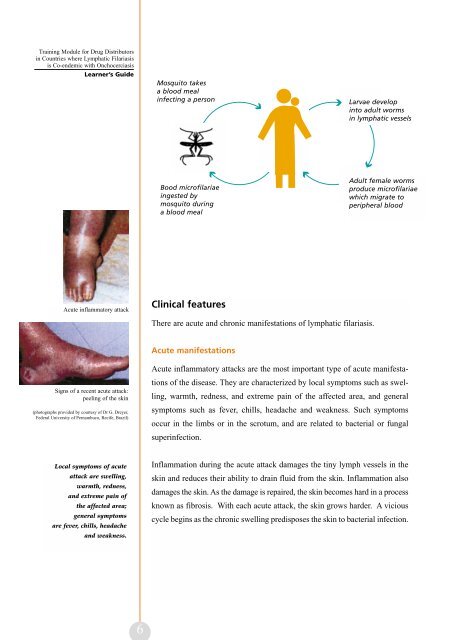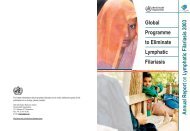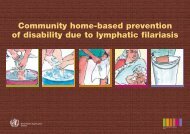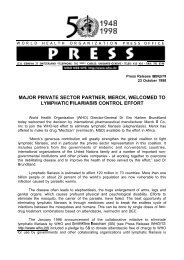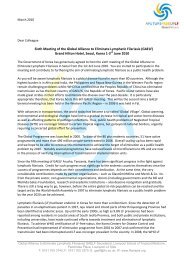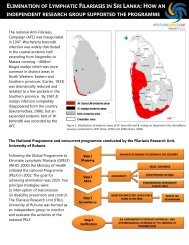Learner's Guide - Global Alliance to Eliminate Lymphatic Filariasis
Learner's Guide - Global Alliance to Eliminate Lymphatic Filariasis
Learner's Guide - Global Alliance to Eliminate Lymphatic Filariasis
You also want an ePaper? Increase the reach of your titles
YUMPU automatically turns print PDFs into web optimized ePapers that Google loves.
Training Module for Drug Distribu<strong>to</strong>rs<br />
in Countries where <strong>Lymphatic</strong> <strong>Filariasis</strong><br />
is Co-endemic with Onchocerciasis<br />
Learner’s <strong>Guide</strong><br />
Mosqui<strong>to</strong> takes<br />
a blood meal<br />
infecting a person<br />
Larvae develop<br />
in<strong>to</strong> adult worms<br />
in lymphatic vessels<br />
Bood microfilariae<br />
ingested by<br />
mosqui<strong>to</strong> during<br />
a blood meal<br />
Adult female worms<br />
produce microfilariae<br />
which migrate <strong>to</strong><br />
peripheral blood<br />
Acute inflamma<strong>to</strong>ry attack<br />
Clinical features<br />
There are acute and chronic manifestations of lymphatic filariasis.<br />
Acute manifestations<br />
Signs of a recent acute attack:<br />
peeling of the skin<br />
(pho<strong>to</strong>graphs provided by courtesy of Dr G. Dreyer,<br />
Federal University of Pernambuco, Recife, Brazil)<br />
Acute inflamma<strong>to</strong>ry attacks are the most important type of acute manifestations<br />
of the disease. They are characterized by local symp<strong>to</strong>ms such as swelling,<br />
warmth, redness, and extreme pain of the affected area, and general<br />
symp<strong>to</strong>ms such as fever, chills, headache and weakness. Such symp<strong>to</strong>ms<br />
occur in the limbs or in the scrotum, and are related <strong>to</strong> bacterial or fungal<br />
superinfection.<br />
Local symp<strong>to</strong>ms of acute<br />
attack are swelling,<br />
warmth, redness,<br />
and extreme pain of<br />
the affected area;<br />
general symp<strong>to</strong>ms<br />
are fever, chills, headache<br />
and weakness.<br />
Inflammation during the acute attack damages the tiny lymph vessels in the<br />
skin and reduces their ability <strong>to</strong> drain fluid from the skin. Inflammation also<br />
damages the skin. As the damage is repaired, the skin becomes hard in a process<br />
known as fibrosis. With each acute attack, the skin grows harder. A vicious<br />
cycle begins as the chronic swelling predisposes the skin <strong>to</strong> bacterial infection.<br />
6


